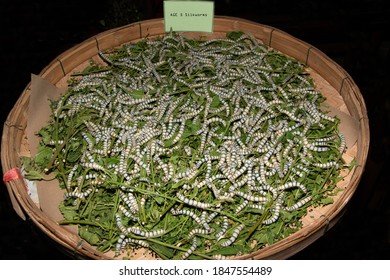
The **silkworm larvae** undergo a series of growth phases or instars, and each stage has its own dietary needs. Just like how a toddler has different meal requirements than a teenager, these little munchers need specific types of food to reach their full potential. Knowing how to feed them correctly helps ensure you have robust, healthy larvae ready to spin some silk!
Understanding Silkworm Larvae Growth Stages
Silkworms go through a remarkable journey during their larval stage, passing through several growth phases. Generally, they have five instars. During each one, they grow significantly, and their demand for food increases as they prepare for their metamorphosis.
– **First Instar (Day 1-3)**: Upon hatching, the larvae are tiny and fragile, about the size of a grain of rice. They’re often fed finely chopped mulberry leaves or specialized silkworm feed. They need frequent feeding, about three to four times a day, since their energy reserves are low.
– **Second to Fifth Instar (Day 4-28)**: As they grow, their appetite skyrockets, and they’ll consume much larger amounts of food. The second instar can eat whole mulberry leaves, and this continues through to the fifth instar, where they can consume up to 10 times more than they did in the first instar. You might be wondering how much that is—about 20 times their body weight in total!
Here’s the thing: adjusting the feeding schedule according to these stages means keeping an eye on their size and behavior. They’ll eat more during the day, so make sure you’re providing fresh food consistently.
Creating a Feeding Schedule
Now that you understand the growth stages, let’s dive into how to create a feeding schedule. A consistent feeding routine is essential for healthy silkworm larvae. You can think of it as setting a meal plan for your kids—with regular, balanced servings to keep their energy levels high.
Start by dividing their diet into portions based on their growth stage:
- First Instar: Feed 3-4 times a day with small, finely chopped leaves.
- Second Instar: Increase feeding to 3-4 times a day with larger leaf pieces.
- Third to Fifth Instar: Provide food every 2-3 hours and ensure it’s fresh and plentiful.
Keep track of how much they’re eating. If you notice leftovers, it might be time to scale back a bit. On the flip side, if they’re gobbling everything up, you might need to increase the portions.
Choosing the Right Food for Silkworms
Feeding silkworms isn’t just about frequency; it’s also about quality. The primary food source for silkworm larvae is **mulberry leaves**, but there are alternatives you can consider.
– **Fresh Mulberry Leaves**: These are the gold standard. They’re high in nutrients and moisture, perfect for growing larvae. Make sure the leaves are free of pesticides or chemicals.
– **Commercial Silkworm Feed**: This can be an excellent substitute if mulberry leaves aren’t available. Look for a high-quality, protein-rich formula designed specifically for silkworms.
– **Alternative Greens**: In a pinch, some people have success feeding silkworms chopped leaves from other plants like white mulberry or osage orange. Just be cautious; not all plants are suitable for silkworms.
Don’t forget to wash the leaves! Dust and pollutants can affect their health. Giving them clean, fresh food is like serving a nutritious meal to a loved one—you want the best for them.
Monitoring Larvae Behavior and Health
As you implement your feeding schedule, keep a close eye on the larvae’s behavior. Healthy silkworms are typically active and exhibit a robust appetite. If they’re sluggish or refusing to eat, it might signal an underlying issue.
Watch for signs of good health:
– **Bright Color**: Healthy larvae should have a vibrant appearance. Dull or pale colors can indicate stress or poor nutrition.
– **Activity Level**: They should be moving around actively. If many are huddled together and not exploring their environment, something might be off.
If you notice any unusual behavior, such as a drastic drop in eating or lethargy, it’s time to reassess their food and environment. Changing up their feed occasionally might help spark their appetite if they seem bored with what they’re getting.
Common Mistakes in Feeding Silkworms
Even seasoned silkworm enthusiasts can slip up in their feeding routines. Here are some common pitfalls to avoid:
– **Overfeeding**: While it’s tempting to give them as much food as possible, overfeeding can lead to mold and waste in their container, creating an unhealthy environment. Stick to the portion guidelines based on their instar.
– **Underfeeding**: On the other hand, not providing enough food can stunt their growth. This is especially critical during the later instars when their nutritional needs peak.
– **Poor Food Quality**: Using old or spoiled leaves can lead to health issues. Always opt for fresh, clean food. If you’re using commercial feed, check the expiration date.
In the grand scheme, these mistakes can hinder your larvae from becoming strong and ready for the next stage of their life cycle. Catching these early can save you a lot of heartache down the road.
Final Thoughts on Feeding Silkworm Larvae
Feeding schedules for growing silkworm larvae may seem straightforward, but they play a crucial role in the health and development of these fascinating creatures. By understanding their growth stages, creating a structured feeding schedule, and monitoring their health, you can help ensure that your silkworms grow up healthy and strong.
Remember, it’s about striking a balance between quality and quantity. Check in on your larvae regularly, and don’t hesitate to make adjustments as needed. With a little patience and care, you’ll be on your way to raising thriving silkworms ready to produce the finest silk!
By fostering their development properly, you’re not just feeding them; you’re shaping the life cycle of a beautiful and industrious creature. Happy raising!
